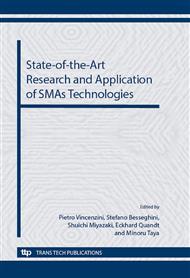p.69
p.75
p.81
p.87
p.92
p.103
p.113
p.119
p.125
Devices for Rehabilitation Applications
Abstract:
Recent research is showing that Shape Memory Alloys (SMA) can be advantageously employed for a number of applications in Rehabilitation Medicine and the related field of Neuroscience. This innovative use of SMA was investigated with the specific aim of improving the treatment approach to neurological patients with sequelae from stroke, traumatic brain injury, cerebral palsy, etc. Several examples of devices built for this purpose will be presented together with an outline of the reasons why the shape-memory and pseudoelastic effects can be regarded as interesting resources on account of scientific, technical and clinical reasons. In particular the design and functioning of an SMA-based ankle exerciser and pseudoelastic repositioning splints for the upper and lower limbs will be discussed in relation with results of neurophysiologic and clinical tests. The main observations so far suggest that this type of devices is able to support patients’ physical rehabilitation by adapting to changing conditions and needs during functional recovery. Furthermore, due to their improved tolerability relative to traditional treatments SMA devices can be used for longer times and tend to produce interesting effects in the control of spastic syndromes.
Info:
Periodical:
Pages:
103-112
Citation:
Online since:
September 2012
Authors:
Keywords:
Price:
Сopyright:
© 2013 Trans Tech Publications Ltd. All Rights Reserved
Share:
Citation:


